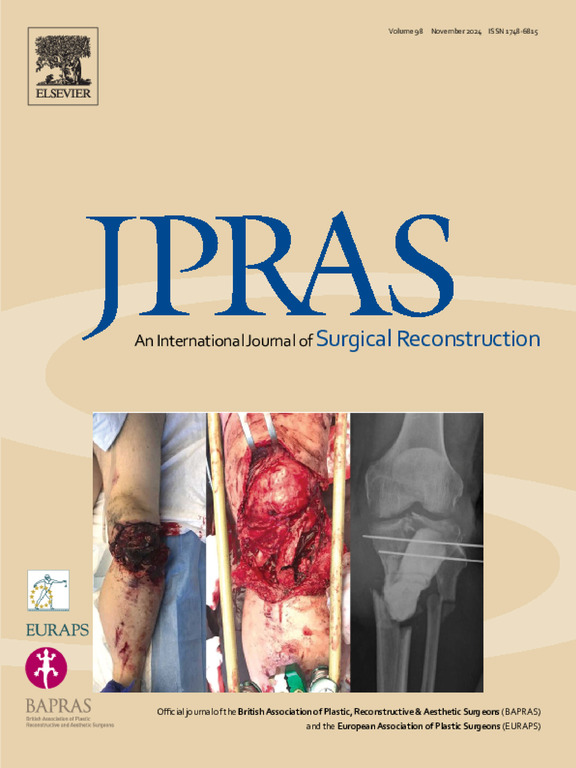蛋白作为术前预测因子-低白蛋白血症对缩乳手术30天预后的影响
IF 2
3区 医学
Q2 SURGERY
Journal of Plastic Reconstructive and Aesthetic Surgery
Pub Date : 2024-11-20
DOI:10.1016/j.bjps.2024.11.011
引用次数: 0
摘要
背景:作为营养不良的生物标志物,低白蛋白血症与手术不良结果有关;然而,其对缩胸手术的影响尚未得到充分证明。方法查询美国外科医师学会国家手术质量改进项目数据库,确定2008年至2022年间接受缩胸手术的患者。患者按术前白蛋白水平正常(≥3.5 g/dL)和低白蛋白血症(<3.5 g/dL)分组。术前、术中和术后30天的结果,包括并发症和再入院,采用单变量检验和多变量logistic回归进行比较。结果共纳入7277例,其中96% (n = 6964)为白蛋白正常值,4% (n = 298)为低白蛋白血症。低白蛋白血症患者的体重指数明显高于对照组(37.1±8.1 vs. 33.3±6.3 kg/m²,p <;0.001),并且更有可能是黑人或非裔美国人(49.0比27.8%,p <;0.001)。糖尿病等合并症(14.7% vs. 7.4%, p <;0.001),慢性阻塞性肺疾病(4.0 vs. 1.0%, p <;0.001),高血压(35.2 vs 26.3%, p = 0.002)在低白蛋白血症组中更为普遍。低白蛋白血症与并发症风险显著增加相关(13.8 vs 6.1%, p <;0.001),表面切口感染(7.0比2.6%,p = 0.001)和计划外再入院(3.4比1.4%,p = 0.05)的发生率较高。多变量分析证实低白蛋白血症是术后并发症(OR 1.96, p = 0.001)、内科并发症(OR 2.62, p = 0.02)和手术并发症(OR 1.91, p = 0.02)的独立预测因子。结论低白蛋白血症显著增加缩胸术后30天并发症的发生。术前营养评估和优化对于改善手术结果至关重要,特别是对于高体重指数和合并症的患者。本文章由计算机程序翻译,如有差异,请以英文原文为准。
Protein as a preoperative predictor – Impact of hypoalbuminemia on 30-day outcomes of breast reduction surgery
Background
Hypoalbuminemia, a biomarker of malnutrition, has been associated with adverse surgical outcomes;, however, its impact on breast reduction surgery is not yet well-documented.
Methods
We queried the American college of surgeons national surgical quality improvement program database to identify patients who underwent breast reduction surgery between 2008 and 2022. Patients were grouped by preoperative normal albumin levels (≥3.5 g/dL) and hypoalbuminemia (<3.5 g/dL). Preoperative, intraoperative, and 30-day postoperative outcomes, including complications and readmissions, were compared using the univariate tests and multivariable logistic regression.
Results
We included a total of 7277 cases, among whom 96% (n = 6964) had normal albumin values and 4% (n = 298) had hypoalbuminemia (n = 298). Patients with hypoalbuminemia showed a significantly higher body mass index (37.1 ± 8.1 vs. 33.3 ± 6.3 kg/m², p < 0.001) and were more likely to be Black or African American (49.0 vs. 27.8%, p < 0.001). Comorbidities such as diabetes (14.7 vs. 7.4%, p < 0.001), chronic obstructive pulmonary disease (4.0 vs. 1.0%, p < 0.001), and hypertension (35.2 vs. 26.3%, p = 0.002) were significantly more prevalent in the hypoalbuminemia group. Hypoalbuminemia was associated with a significantly increased risk of complications (13.8 vs. 6.1%, p < 0.001), with higher rates of superficial incisional infections (7.0 vs. 2.6%, p = 0.001) and unplanned readmissions (3.4 vs. 1.4%, p = 0.05). Multivariable analysis confirmed hypoalbuminemia as an independent predictor of postoperative complications (OR 1.96, p = 0.001), medical complications (OR 2.62, p = 0.02), and surgical complications (OR 1.91, p = 0.02).
Conclusion
Hypoalbuminemia significantly raises the risk of 30-day postoperative complications in breast reduction surgery. Preoperative nutritional assessment and optimization are crucial in improving surgical outcomes, particularly in patients with high body mass index and comorbidities.
求助全文
通过发布文献求助,成功后即可免费获取论文全文。
去求助
来源期刊
CiteScore
3.10
自引率
11.10%
发文量
578
审稿时长
3.5 months
期刊介绍:
JPRAS An International Journal of Surgical Reconstruction is one of the world''s leading international journals, covering all the reconstructive and aesthetic aspects of plastic surgery.
The journal presents the latest surgical procedures with audit and outcome studies of new and established techniques in plastic surgery including: cleft lip and palate and other heads and neck surgery, hand surgery, lower limb trauma, burns, skin cancer, breast surgery and aesthetic surgery.

 求助内容:
求助内容: 应助结果提醒方式:
应助结果提醒方式:


